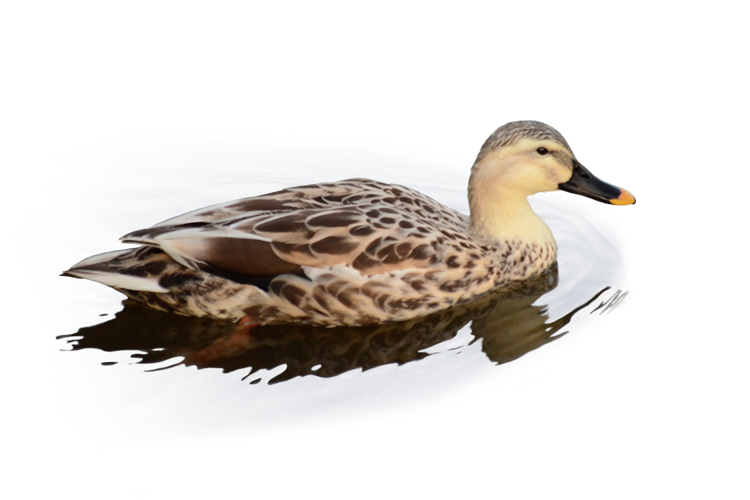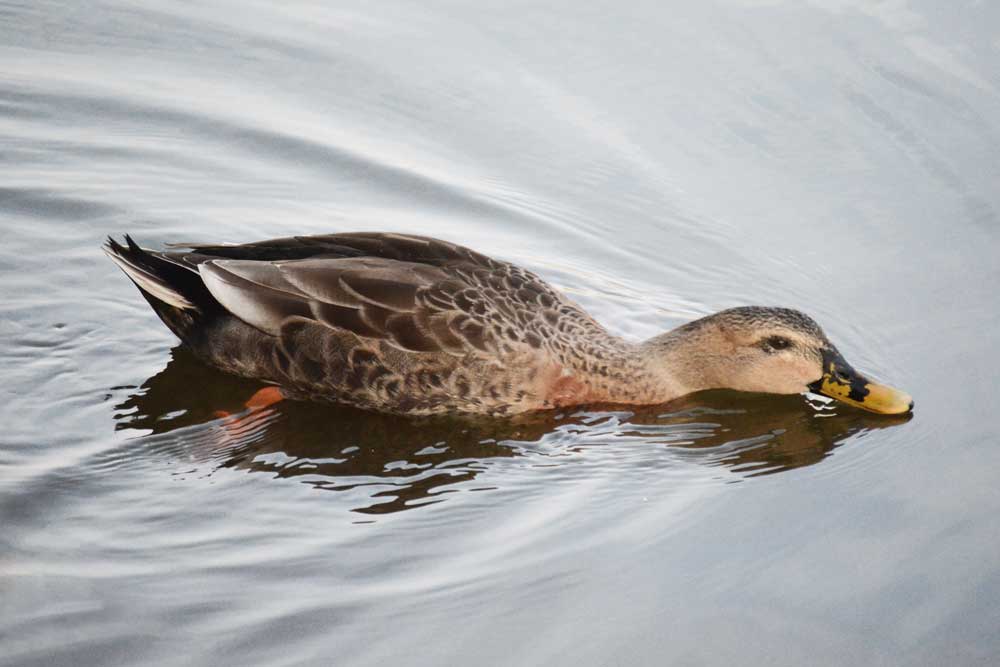
Anas zonorhyncha (Swinhoe, 1866)
カルガモの行進
Marching Spot-billed Duck Family
全長約60cm。アジアの温帯から亜熱帯に広く分布し、日本では河川や池沼、さらには海上でも繁殖する身近なカモ類です。本州以南では一年中見られる留鳥で、北海道では夏鳥として飛来します。全体は茶褐色で首は淡色、顔に2本の暗色線が入り、脚は橙色をしています。黒い嘴の先端にある黄色い斑はカルガモ最大の特徴で、観察時の重要な識別点となります。
羽色の季節変化が小さいため地味な印象を受けますが、次列風切にある群青色の「翼鏡」は非常に美しく、飛翔時にひときわ鮮やかに輝きます。翼鏡の色や模様は種や性別によって異なり、群れの中で仲間を見分ける役割を果たしていると考えられています。
名前の由来には、マガモより軽いことから「軽鴨」となった説、万葉集に詠まれた「軽ケ池」にちなむ説、かつて「黒鴨」と呼ばれた名が変化した説などがあります。また、中国語で「太平洋黑鴨」(Anas superciliosa)とされる種は外見がよく似ますが、嘴の黄色斑がないことで区別できます。
日本では親子で列をつくって歩く姿が広く知られています。1984年、皇居の池へ向かうため道路を横断した親子がニュースで話題となり、その後“カルガモの引っ越し”は初夏の風物詩として定着しました。雛はまだ飛べないため徒歩で水辺へ移動し、そこで採餌を覚えて成長していきます。
The Spot-billed Duck measures about 60 cm in length and is widely distributed from the temperate to subtropical regions of Asia. In Japan, it breeds in rivers, ponds, marshes, and even coastal waters. It is a resident bird in areas south of Honshu and appears as a summer visitor in Hokkaido. The overall plumage is brown, the neck is pale, two dark stripes run across the face, and the legs are orange. Its most distinctive feature is the yellow patch at the tip of its otherwise black bill, which serves as an important clue for identification.
Although its plumage shows little seasonal variation and may appear plain, the deep bluish-purple “speculum” on the secondary wing feathers is remarkably beautiful, shining vividly in flight when the wings are spread. The color and pattern of the speculum differ by species and sex, and are thought to play a role in recognizing individuals within a flock.
The origin of its Japanese name has several explanations: one suggests it was called “karugamo” because it is lighter than the Mallard, while another links it to “Karugeno-ike,” a pond mentioned in the Man’yōshū. There is also a theory that it evolved from an older name meaning “black duck.” In addition, the species referred to in Chinese as “Pacific Black Duck” (Anas superciliosa) closely resembles the Spot-billed Duck but lacks the yellow patch on the bill.
In Japan, the image of a parent duck leading its ducklings in a line is widely known. In 1984, a family of ducks crossing a road on their way to a pond in the Imperial Palace became a nationwide topic, and since then, these “duck parades” have become an early-summer tradition in urban areas. Ducklings cannot fly yet, so they walk to nearby water bodies, where they learn to forage and grow.

A hybrid of a spot-billed duck and a mallard
参考文献
サントリーの愛鳥活動 | 日本の鳥百科 | カルガモ 2025年11月24日閲覧
日本経済新聞 | カルガモ、実はおしゃれさん 翼の内側に輝く羽根 | (2013年9月7日) 2025年11月24日閲覧
新潟県 | 環境局 環境対策課 | 翼標本(カモ目) 2025年11月24日閲覧
三鷹市 | みたかいきもの図鑑 | カルガモ 2025年11月24日閲覧
葦は、たのしく | 軽鴨は軽いの?~カルガモ、その名前の由来~ | (2025年7月30日) 2025年11月24日閲覧
Baidu百科 | 太平洋黑鸭 2025年11月24日閲覧
和楽web | 東京・目白の日本庭園へ、カルガモの子育てを見にいこう!| 山本毅 (2019年5月17日) 2025年11月24日閲覧
めざましmedia | 【突然】東京・環状七号線の道路上で“カルガモ親子”が大行進 陸橋の上までどうやって登ってきた? | (2024年7月5日) 2025年11月24日閲覧